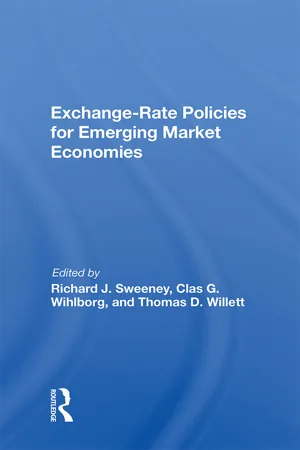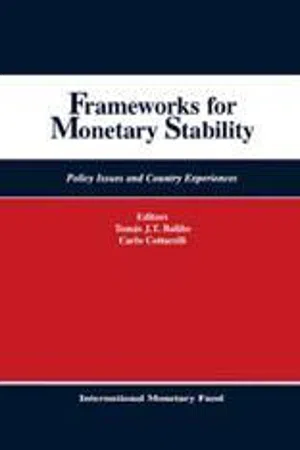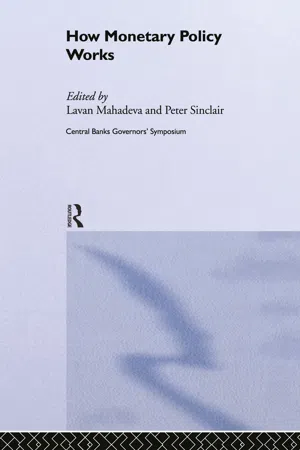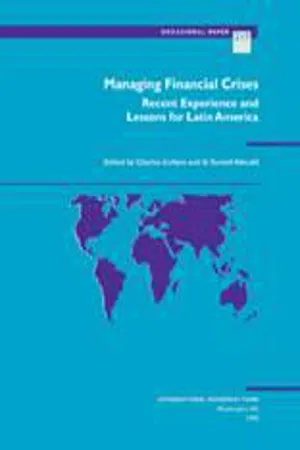Economics
Nominal Anchor
A nominal anchor is a reference point used by central banks to guide monetary policy and stabilize prices. It is typically a specific target, such as an inflation rate or a fixed exchange rate, that the central bank aims to achieve through its policy actions. By providing a clear signal to the public and financial markets, a nominal anchor helps to anchor expectations and promote economic stability.
Written by Perlego with AI-assistance
Related key terms
Related key terms
1 of 4
Related key terms
1 of 3
5 Key excerpts on "Nominal Anchor"
- eBook - ePub
- Jean-OIiver Hairault, Thepthida Sopraseuth(Authors)
- 2003(Publication Date)
- Routledge(Publisher)
In the last 20 years, the focus of debates on exchange-rate systems has shifted away from traditional arguments to issues related to the credibility of monetary policy and its ability to serve as a credible constraint on the value of domestic money, the so-called Nominal Anchor. As convincingly argued by Mishkin (1999), this is a necessary element in successful monetary policy regimes, for at least two reasons. First, from a pure technical viewpoint, a Nominal Anchor provides conditions that make the price level uniquely determined, which is obviously necessary for price stability. It helps achieving this by tying down inflation expectations directly through its constraint on the value of domestic money. Moreover, a Nominal Anchor can be thought of more broadly as a constraint on discretionary policy that helps weaken the time-inconsistency problem so that in the long run, price stability is more likely to be achieved. The time-inconsistency problem arises because discretionary policy at each point in time can lead to very poor long-run outcomes.A fixed exchange rate has several advantages, from the viewpoint of providing a Nominal Anchor.13 First of all, it pins down the inflation rate for traded goods, and thus directly contributes to keeping inflation under control. Moreover, if it is credible (in the case of a currency board, for instance) it also anchors inflation expectations to the inflation rate in the anchor country to whose currency it is pegged. Therefore, it is not surprising that an exchange-rate peg has been used successfully to control inflation in both industrialized and emerging-market countries. In this section, we study the possibility that a country with weak monetary institutions could be made better off under a fixed exchange-rate regime, via the stabilization of inflationary expectations. We assume that weak monetary policy is embedded in an interest-rate rule under which the path to the non-stochastic steady state is not uniquely determined by initial conditions. Therefore, sudden changes in agents’ expectations make the economy jump from one transitional path to another, producing fluctuations independent of those due to exogenous shocks. This occurs because the interest-rate rule dictates a weak response of the nominal interest rate to inflation expectations, which become self-fulfilling.14 - Richard J Sweeney(Author)
- 2019(Publication Date)
- Routledge(Publisher)
Chapter 3 by Wihlborg and Willett in this volume). Such countries should adopt domestically rather than internationally based anchors. The final section offers brief concluding remarks.What Is a Nominal Anchor?
The term Nominal Anchor is used in two ways in the literature. Anchors are described as (1) long term, fixed, and nonadjustable, or (2) short term, temporary, and adjustable. In both cases, Nominal Anchors are viewed as targets for monetary policy (Flood and Mussa 1994). If the definition of an anchor is a target for monetary policy, then both descriptions are consistent. If a government hopes to gain long-run discipline and credibility from an anchor, then only the first description is appropriate.In the debate surrounding the use of exchange rates as Nominal Anchors, analysts often fail to explain whether they view the exchange rate anchor as temporary or permanent. Quite frequently reference is made to Nominal Anchors without definition or discussion of their meanings. Because the emphasis is often on discipline and credibility effects, the idea of anchors as long-run constraints is usually strongly implicit (Corden's 1994 paper is an exception in that he explicitly discusses the time dimension). Frankel is quite explicit in describing the Nominal Anchor argument as "a prescription to peg exchange rates firmly as a credible precommitment on the part of monetary authorities not to inflate" (1996:153). Clearly such a definition is not consistent with treating a temporary peg as part of a Nominal Anchor strategy, yet one frequently encounters references to changeable or temporary Nominal Anchors (see, for example, Bruno 1991b, Claassen 1991, Cooper 1991, Edwards 1997, and Paredes and Sachs 1991). Indeed, policies are often implemented in which the exchange rate is used as a short-term Nominal Anchor, meant to be abandoned at some unspecified future date, and yet credibility effects are often assumed. For example, Sachs (1997:250) argues that an important argument in favor of temporary pegging at the beginning of a stabilization program is its symbolic value: "the commitment to a pegged exchange rate is a very visible signal of the government, that may increase confidence and stop a flight from the currency." Likewise, Bofinger et at (1997:19) argue that "if a central bank adopts an exchange rate target, this reflects a strong commitment to macroeconomic stabilization." Exchange rate pegging is certainly a strong indicator that the government is undertaking a major stabilization effort, but we question whether it should convey a credible signal to economic agents that the stabilization programs will be sustained long enough to succeed. Indeed, writers such as Calvo and Végh (1994) and Kiguel and Liviatan (1992, 1991) offer imperfect credibility as an explanation for why exchange rate based stabilization in chronic high inflation countries often leads to an initial boom.7- INTERNATIONAL MONETARY FUND(Author)
- 1994(Publication Date)
- INTERNATIONAL MONETARY FUND(Publisher)
Given the close integration of European economies, the anchor country in pursuing its own goal of price stability does in effect take into account economic conditions in other countries, but only to the extent that they affect its own inflation rate. Its monetary authorities, with their strong anti-inflation credentials, can no doubt from time to time give additional weight to circumstances in neighboring countries, without affecting their credibility or the strength of the anchor. However, once the anchor country begins to adapt its policies to the needs of follower countries on a regular basis, or for a sustained period, especially in face of domestic inflationary pressures, its role as anchor begins to become blurred. If there is a consensus that a coordinated approach to policy is to become a general feature of policies, a common anchor would be required, such as the common monetary policy that will underpin EMU. Other papers in this book deal with monetary union in Europe.The Choice of Nominal Anchor . The exchange rate anchor has lost some of its lustre after the recent year-long crisis in the ERM, rekindling the debate on the appropriate orientation for monetary policy in European countries and with this debate have come proposals for alternative anchors. While a detailed consideration of such issues goes beyond the scope of this paper, a few comments may be helpful. First, as discussed earlier, the Nominal Anchor is not the only reason for seeking exchange rate stability. Second, the experience of Austria and the Netherlands underlines the fact that nominal exchange rate pegs are not necessarily fragile. In both countries, the strength of the peg is assisted by a very close integration with the German economy; in recent years, for example, the inflation pattern in both countries has followed that of Germany more closely than was the case for other countries. However, the long history of following the deutsche mark and the clear disinclination of policymakers to cast doubt in any way on the link have also been critical.Third, alternative anchors also suffer from drawbacks. The money supply has long been seen as the principal alternative to the exchange rate as a Nominal Anchor. For many countries in Europe, however, volatility in the velocity of money represents a strong argument against such an approach. Some European countries with strong records of relative price stability—in particular, Germany and Switzerland—have relied on monetary targeting to provide the general orientation to policy. These, however, are seen by many as being special cases, where the long-standing credibility of the monetary authorities has allowed them significant discretion in the implementation of policy. The changes in financial markets related to the ongoing process of market integration in Europe are seen to weaken further the case for monetary targeting, at least at the level of the individual country. It does, however, remain a candidate for the operating framework to be chosen by a future European central bank.- eBook - ePub
- Lavan Mahadeva, Peter J N Sinclair(Authors)
- 2004(Publication Date)
- Routledge(Publisher)
Given that the goal of monetary policy is to achieve or maintain a low rate of inflation or price stability, how would a central bank go about achieving it? The typical answer to this question is the adoption by the central bank of a Nominal Anchor or intermediate target. Over the years, three principal kinds of Nominal Anchor have been used by central banks as a way of focusing the conduct of policy and tying down or anchoring the expectations of the public—targeting monetary aggregates, fixing the exchange rate, and targeting the forecast rate of inflation within the framework of an inflation-targeting regime.Twenty-five years ago, most industrialized countries had just entered a period of targeting monetary aggregates. This was done in the context of trying to bring down the rate of inflation from the high level that it had reached in the early 1970s to the much lower level that was believed to be necessary for good economic performance. The intent of the policy was gradually to bring down the targeted rate of growth of some measure of money (narrow in some countries, broad in others) from a high starting point to a much lower level and thereby wring inflation out of the system.There were different views of the mechanism at work that would link the deceleration of money growth to a decline in price inflation. The more monetarist view focused on a direct causal link between money growth and the rate of inflation. The typical view in central banking circles, in contrast, was that the mechanism operated through more traditional, structural relationships. Thus, too high a rate of inflation (i.e. one that was higher than consistent with the targeted growth rate of money) would result in a rise in the rate of growth of money demanded above the target rate, leading the central bank to raise policy interest rates. This would lead to a rise in short-term market interest rates, and, to a lesser extent, long-term interest rates, and this in turn would slow the growth of aggregate demand (relative to capacity) and feed into lower inflation.Essential to this sequence of events were two preconditions. The first was stability in the demand for money. This was necessary so that the appropriate signal would be forthcoming regarding the pace of growth of nominal aggregate demand and the needed change in interest rates. Second, the response of interest rates to the deviation between money and targeted money had to exert appropriate effects on demand and inflation. If the relationship of money demand to interest rates was too elastic, then an excessively high rate of expansion of aggregate demand would give rise to only small increases in interest rates (because that was all that was needed to return money growth to its targeted rate), which might not be sufficient to effect a slower growth of aggregate demand very quickly (or at all). - G. Kincaid, and Charles Collyns(Authors)
- 2003(Publication Date)
- INTERNATIONAL MONETARY FUND(Publisher)
The major issue that confronted the authorities was how to pursue monetary policy without relying on a single clear and operational Nominal Anchor. Countries can in principle choose to target a money aggregate or inflation. However, countries in this sample rarely followed a money anchor in the aftermath of a crisis. In a context where inflation is impossible to predict with any confidence, money targeting would seem to offer the promise of setting a money target as a clear Nominal Anchor—its achievement assures that there is at least some anchor to the price level. It rarely worked that way in practice, for several reasons:- Because of the unpredictability and instability of money demand, monetary aggregate targets rarely served to guide monetary policy execution. Monetary targets were rarely binding, since they were usually widely missed (Mexico) or overachieved (Korea, Thailand, Brazil). These errors were mostly due to surprises in money demand or net international reserves, the latter often the result of large errors in predicting capital flows (Mexico), and did not serve to indicate the adequacy of the monetary stance.13
- Even if a money target is met, the exchange rate may still be subject to wide swings. These fluctuations, particularly during the panic-prone post-crisis period, risk feeding rapidly into expectations and being validated by balance sheet effects and wage and price-setting dynamics. Monitoring of monetary policy therefore needed to rely on indicators that were observable at high frequencies and bore a direct relationship to market conditions.14
- The low interest elasticity of money demand in the short run implies that any attempt to strictly control the money supply in the short run tends to result in unbearably high or volatile interest rates (e.g., Turkey, for the first few days after its float). Nonetheless, monetary aggregates can still play a useful supportive role, particularly as objective “trip wires” for cases of egregious failure to conduct an appropriate monetary policy, as has been highlighted by Ghosh and others (2002 ).15
Index pages curate the most relevant extracts from our library of academic textbooks. They’ve been created using an in-house natural language model (NLM), each adding context and meaning to key research topics.
Explore more topic indexes
Explore more topic indexes
1 of 6
Explore more topic indexes
1 of 4




